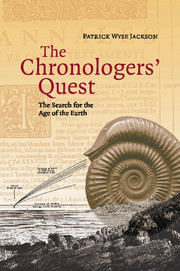Book contents
- Frontmatter
- Contents
- List of illustrations
- List of tables
- Preface
- Acknowledgements
- 1 The ancients: early chronologies
- 2 Biblical calculations
- 3 Models of Aristotelian infinity and sacred theories of the Earth
- 4 Falling stones, salty oceans, and evaporating waters: early empirical measurements of the age of the Earth
- 5 Thinking in layers: early ideas in stratigraphy
- 6 An infinite and cyclical Earth and religious orthodoxy
- 7 The cooling Earth
- 8 Stratigraphical laws, uniformitarianism and the development of the geological column
- 9 ‘Formed stones’ and their subsequent role in biostratigraphy and evolutionary theory
- 10 The hour-glass of accumulated or denuded sediments
- 11 Thermodynamics and the cooling Earth revisited
- 12 Oceanic salination reconsidered
- 13 Radioactivity: invisible geochronometers
- 14 The Universal problem and Duck Soup
- Bibliography
- Index
4 - Falling stones, salty oceans, and evaporating waters: early empirical measurements of the age of the Earth
Published online by Cambridge University Press: 02 December 2009
- Frontmatter
- Contents
- List of illustrations
- List of tables
- Preface
- Acknowledgements
- 1 The ancients: early chronologies
- 2 Biblical calculations
- 3 Models of Aristotelian infinity and sacred theories of the Earth
- 4 Falling stones, salty oceans, and evaporating waters: early empirical measurements of the age of the Earth
- 5 Thinking in layers: early ideas in stratigraphy
- 6 An infinite and cyclical Earth and religious orthodoxy
- 7 The cooling Earth
- 8 Stratigraphical laws, uniformitarianism and the development of the geological column
- 9 ‘Formed stones’ and their subsequent role in biostratigraphy and evolutionary theory
- 10 The hour-glass of accumulated or denuded sediments
- 11 Thermodynamics and the cooling Earth revisited
- 12 Oceanic salination reconsidered
- 13 Radioactivity: invisible geochronometers
- 14 The Universal problem and Duck Soup
- Bibliography
- Index
Summary
In the latter part of the seventeenth century in England and on the Continent there emerged scholars prepared to argue against the various sacred theories of the Earth and to discuss the possibility that the Earth was older, possibly immeasurably older than these theories would allow. The link to the biblical texts was weakening and two men in England, in particular, demonstrated or suggested that scientific observations and scientific experimentation could produce empirical data from which to deduce a number in years for the age of the Earth. Today one of these men is little known even within scientific circles, whereas the second remains very well known on account of his prediction of the timing of a returning celestial object.
EDWARD LHWYD
Oxford has long been a centre of learning, with its many colleges, spires, dons and students. Today, students bicycle at speed from lodgings to lectures, dodging tourists and thinking about their next meal or assignation. On Cornmarket Street stands the small church of St Michael at the Northgate. Here, as we shall see, one might expect to find a memorial to the first geochronologist that has attracted my attention. This church, the Saxon tower of which dates from the eleventh century, is the oldest building in Oxford. How many cycle past and never enter its doors? Probably hundreds every day. If any one of these stopped, parked his bicycle by the entrance and walked inside he would find no fitting memorial.
- Type
- Chapter
- Information
- The Chronologers' QuestThe Search for the Age of the Earth, pp. 47 - 65Publisher: Cambridge University PressPrint publication year: 2006



